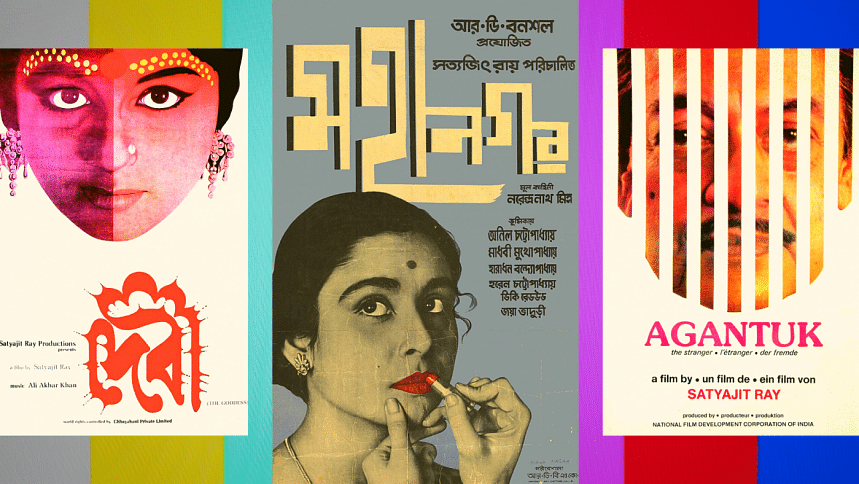The Artistry of Classic Bangla Movie Posters

Weaved in familiarity, entrenched by the unknown -- the movies of Satyajit Ray, Mrinal Sen, and Ritwik Ghatak have layers to them that transcend themes and time, and have consolidated themselves amongst cinephiles as classics. Their films are meticulously crafted in almost every aspect, whether it's the technicalities of the cinematography or the poetic dialogues that leave a lasting impression on viewers. Such attention to detail finds itself in places outside of the film too.
Ray started his career as a commercial illustrator and made a majority of his film's posters himself, combining his distinct voice and local influences. With specialised Bangla typography, usage of primary colours and borrowed aspects from the Dadaist movement, his posters are timeless.
Bangla typography, even in the contemporary era, leaves a lot to be desired. Much of it is unexplored and most commercial type foundries tend to conform to the norm. However, Ray was breaking expectations from day one. The poster for Sonar Kella utilises a stylised geometric, paper cutout style of Bangla lettering, filled with an eye-catching red-maroon. The forms change in pattern with each letter, rendering the cutouts with a persona of their own. Other renditions of similar out-of-box typography are seen in the posters of Hirak Rajar Deshe and Mahanagar.
This multimedia approach to design was unique that Ray pioneered in the field of subcontinental graphic design. His knack for unconformity ranged from child-like doodles to pieces of work which are painfully intricate. Ray's fascination with photography found itself in posters for Nayak, Pather Panchali and Debi.
Elsewhere, Mrinal Sen's posters possess the same uncompromising feel as his films. Rebellious, unsettling, and provoking -- the poster for Calcutta 71 is a combination of illustrations and photography. Similar techniques of Ray's such as collages are used. The typography is a little more grounded and embodies the graffiti that might have been seen on the walls of Kolkata during that era. Posters for Baishey Srabon and Abosheshe also symbolise the profundity of Sen's artistry.
A friend and collaborator of Sen's, Ritwik Ghatak told the same stories of class struggle, a colonised subcontinent, and melancholy of the masses through a different lens. Komal Gandhar has a spine-tingling feel in its promotional poster. A blue backdrop of a familiar rural scene and complimentary alpona fuse to form a unique look. His 1965 opus Subarnarekha offers a juxtaposition of playful colours against a more stern portrait. The contrast is complementary and forces you to gaze back at the poster.
These films went on to define the golden age of Bangla cinema. The experiences of the people, whether told through the nihilistic approach of Mrinal Sen, the piercing reality of Ritwik Ghatak or the humane qualities of Satyajit Ray, document a significant time for the subcontinent. Lands plagued with poverty, famine, and the aftermath of war held stories in every nook and cranny of a new land. Their works have influenced people on a global scale, and spark conversations to this day.
Abir Hossain is a failed SoundCloud Rapper. Tell him you too can't find anything to rhyme oranges with at fb/abir.hossain.19

 For all latest news, follow The Daily Star's Google News channel.
For all latest news, follow The Daily Star's Google News channel. 



Comments